
American Ace Luke: Frank Luke, Jr., American Ace with
21 victories before his death.
|
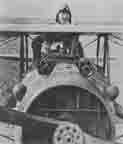
American Ace Rickenbacker: US top ace, Eddie Rickenbacker,
with 26 victories. He survived the war.
|
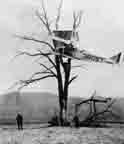
American Crashed Jenny: Curtiss Jenny photographed
after a training accident. The pilot was attempting to land and
the plane finished up in a tree.
|
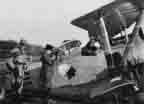
American Lafayette Escadrille Pilot Raoul Lufbery posing
in his Nieuport. Two French sergeants are also seen. One sergeant
is holding "Whiskey," one of the two lion cub mascots
with the squadron. The other cub was named "Soda."
|
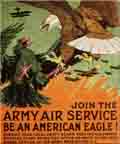
American Recruiting Poster: A powerfully patriotic
recruiting poster calling young Americans into a new military
role. This type of appeal got thousands interested in flying.
|
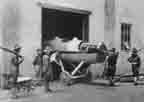
American Trainer 1916: American trainer being readied
for testing in 1916, a year before America entered the war.
|

American 148th Squadron: U.S. pilots flying
British Sopwith Camels readying for take-off from Dunkirk, August
1918.
|
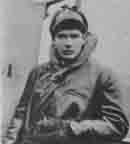
British Ace Mannock: Edward Mannock, Top British Ace
with 73 victories.
|

British Avro 504 Prototype: Avro 504 prototype was
first flown September 18, 1913. Plane is shown in its original
form with warping ailerons. It was propelled by an 80 hp Gnome
engine and averaged an impressive 66.5 mph and came in fourth
in the Hendon Aerial Derby. The Avro 504 served throughout the
war in a wide variety of variants.
|

British Avro 504J Fuselages: This Avro 504 variant,
powered by a powerful 100 hp Gnome Monosoupape engine, became
the standard RFC trainer. The photo shows Avro 504J fuselages
awaiting delivery outside the Avro factory in Manchester.
|

British Bristol F-2B: This photo shows the fighter/bomber
flying over the Alps. Introduced in 1917, the plane could stay
in the air for three hours. Its ceiling was 21,500 feet and it
could reach a maximum speed of 123 mph at 5000 feet.
|

British School for Special Flying: This Royal Flying
Corps flight training school at Gosport was founded in July,
1917, by Major R. R. Smith-Barry, who developed a new training
method, which involved the use of the Gosport Inter-cockpit
Speaking tube. This school was one of the first to receive
the Avro 504J.
|

Canadian Ace Bishop: Billy Bishop, top Canadian ace
with 72 victories to his name.
|

French Ace Fonck: France's top ace, René
Fonck, with 75 victories to his name.
|
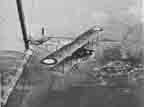
French Ace Nungesser from Air: A French pilot, on his
way to combat, took a picture of Charles Nungesser in his Nieuport
fighter. (See Nungesser)
|
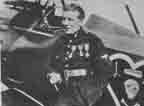
French Ace Nungesser: A wild pilot who constantly broke
the rules, Charles Nungesser was one of World War I's most wounded
pilots. He had a coffin, a black heart, two burning candles,
and a skull and crossbones insignia painted on his plane, as
shown in the photo. He was France's third ranking ace with 45
victories to his name. He survived the war, but was killed on
May 8, 1927 while attempting to fly the Atlantic.
|
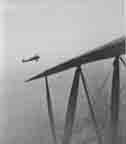
French Farman: This in-flight photo shows a French
Maurice Farman biplane flying over the Western Front in 1914.
|
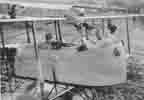
French Farman0001: A Farman pilot and observer demonstrate
the wide forward and overhead arc of machine gun fire that these
early pusher planes could manage.
|
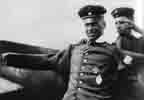
German Ace Boelcke: Oswald Boelcke was possibly the
greatest military aviator of World War I. He was killed in an
accident in October, 1916. In this photo, he is shown being helped
into his flying jacket.
|
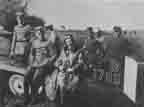
German Ace Richthofen: Manfred von Richthofen ("The
Red Baron") posing beside Anthony Fokker. Both men are sitting
on a crashed Allied plane. Richthofen, without goggles, is on
the left. He is credited with 80 victories.
|

German Aerial Workshop: Photo shows a German aerial
workshop at Adlershof. The tail on the right with "87"
showing was from an Avro 504; the plane's full number was 874.
Plane 874 was shot down during a raid on Freidrichshafen. This
plane, together with Avros 873 and 875 took off from Belfort,
France which was 125 miles from the target. The other two planes
returned safely after being airborne for four hours. The Avro
504 could carry four 20 pound bombs
|

German Balloons Shot Down: This February 1918 photograph
shows two German observation balloons going down.
|
|
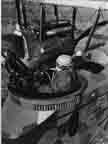
German Bomber Gunner: A German bomber gunner, dressed
for high-altitude flight and sucking on an oxygen tube mans his
machine gun. The plane is a Gotha G-IV bomber. Powered by two
260 horsepower engines, it could carry between 660-1100 pounds
of bombs to a maximum range of 305 miles.
|
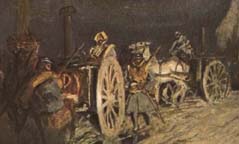 WWI Resource Centre
WWI Resource Centre WWI Resource Centre
WWI Resource Centre